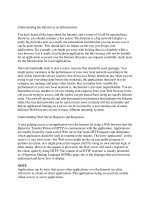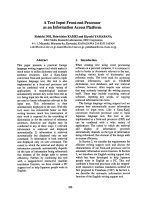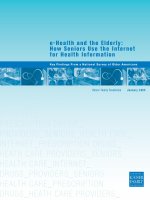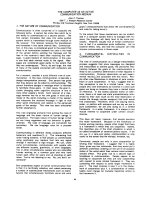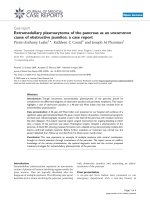- Trang chủ >>
- Sư phạm >>
- Sư phạm tiểu học
The Internet As An Information Resource
Bạn đang xem bản rút gọn của tài liệu. Xem và tải ngay bản đầy đủ của tài liệu tại đây (1.19 MB, 24 trang )
<span class='text_page_counter'>(1)</span><div class='page_container' data-page=1></div>
<span class='text_page_counter'>(2)</span><div class='page_container' data-page=2>
<b>Learning outcomes</b>
By the end of the lesson, students
should be able to:
Evaluate information resources on the
Internet
Cite properly the information
resources found on the Internet
Address ethical, legal and other
issues involved in using the Internet
</div>
<span class='text_page_counter'>(3)</span><div class='page_container' data-page=3>
<b>Scope</b>
What are the issues and concerns in using
the Internet as an information resource?
How to evaluate information resources on
the Internet?
How to cite properly the information
resources found on the Internet?
What are the ethical, legal and other issues
involved in using the Internet?
</div>
<span class='text_page_counter'>(4)</span><div class='page_container' data-page=4>
<b>How to evaluate web sites?</b>
Unlike the case of printed douments quality
of information on the Internet cannot be
guaranteed
Almost anyone can publish on the web
Little editorial review process
Anonymity often makes it difficult to
determine authorship
Information frequently is not dated, and if
dated it is not necessarily very recent
One must develop skills to evaluate
</div>
<span class='text_page_counter'>(5)</span><div class='page_container' data-page=5>
<b>How to evaluate web sites?</b>
Criteria in evaluating Internet resources
Accuracy – free from error and alteration
Authority – credibility of author / publishing
or sponsoring body
Objectivity – creator and/or sponsor’s point
of view / bias
Currency – timeliness of information
Content – scope and depth of material
</div>
<span class='text_page_counter'>(6)</span><div class='page_container' data-page=6>
<b>How to evaluate web sites?</b>
Accuracy
Is it the original document?
If it is not the original, is it authentic? Not
altered or forged?
Is there a way to verify authenticity of the
content?
Were the sources of information well
documented?
How reliable is the information?
Are there any grammatical, spelling, and
</div>
<span class='text_page_counter'>(7)</span><div class='page_container' data-page=7>
<b>How to evaluate web sites?</b>
Authority
Who is the author?
Is the author credible? qualified or an expert
on the subject matter?
Is there a way to know more about the
author? (education, current job position,
publications etc.)
Who is the publisher of the page?
Is it a reputable publishing body?
Check the domain of the URL what does it
</div>
<span class='text_page_counter'>(8)</span><div class='page_container' data-page=8>
<b>How to evaluate web sites?</b>
Objectivity
From which point of view is the information
presented?
Does it show a minimum of bias?
Is it trying to sway opinion?
Does it reflect the aims or purpose of the web
site?
Does the site belong to individuals or
organizations that have a stake on the
matter?
Are any political or philosophical agendas
</div>
<span class='text_page_counter'>(9)</span><div class='page_container' data-page=9>
<b>How to evaluate web sites?</b>
Currency / Timeliness
Is the information dated?
Is it timely? up-to-date?
Are the links current and still available?
Are there indications that the material is
kept current?
</div>
<span class='text_page_counter'>(10)</span><div class='page_container' data-page=10>
<b>How to evaluate web sites?</b>
Content
Who is the target audience of the Web site?
What is the scope of the web site?
How in-depth are the materials?
Is it in line with the purpose of the web site?
Does it provide meaningful and useful
information?
Was the source of information well
</div>
<span class='text_page_counter'>(11)</span><div class='page_container' data-page=11>
<b>How to evaluate web sites?</b>
Design
Does it follow established design principles?
Is the site easy to read and navigate?
Is there a balance between style and
functionality?
Are the links relevant and appropriate?
Are there any accessibility provisions for
special categories of users such as people
with visual impairments?
Does the site use graphics and new
</div>
<span class='text_page_counter'>(12)</span><div class='page_container' data-page=12>
<b>How to evaluate web sites?</b>
Accessibility
Can it be viewed using different browsers?
Does it require a special program to read
the content?
Is the information readily available on the
web site?
Will the site be updated and maintained?
Is the information available for free? for a
</div>
<span class='text_page_counter'>(13)</span><div class='page_container' data-page=13>
<b>How to cite Internet resources?</b>
Internet information resources citation and
style manuals
APA (American Psychological Association) format -
based on APA’s Publication Manual Fifth Edition:
• APA Electronic Reference
/>
MLA (Modern Language Association) format - based
on MLA Handbook for Writers of Research Papers
5th Edition:
• MLA Style: How do I document sources from the World
Wide Web in my works-cited list?
</div>
<span class='text_page_counter'>(14)</span><div class='page_container' data-page=14>
<b>How to cite Internet resources?</b>
Chicago Manual of Style - based on The Chicago
Manual of Style 14th edition
• Citation Style Guides for Internet and Electronic
Sources
/>dex.cfm#Chicago
More examples : Online! A Reference Guide to Using
Internet Resources
</div>
<span class='text_page_counter'>(15)</span><div class='page_container' data-page=15>
Netiquettes - ethics governing Internet
- acceptable behavior on the Net, mostly
related to use of e-mail and relay chat
• For Example:
Be brief, keep paragraphs short
Try to use mixed upper and lowercase
Use CAPITALS & special characters for emphasis only
Do not SPAM or send junk e-mail
Refrain from flaming (sending hate messages)
Follow acceptable standards of politeness as used in
all kinds of communication
Be wary of virus hoaxes, urban legends and chain
letters
</div>
<span class='text_page_counter'>(16)</span><div class='page_container' data-page=16>
Intellectual Property Rights
• Plagiarism – using somebody else’s work and
claiming it as your own
• Copyright Law – protection of the author’s
original work
• Fair Use – reproduction of materials for
educational and research purpose
• Software piracy – theft and illegal reproduction
of software
• File swapping – exchange of digital materials
like audio and video over the Net without the
owner’s permission
</div>
<span class='text_page_counter'>(17)</span><div class='page_container' data-page=17>
Civil liberties – issues regarding the rights
of an individual
• Freedom of speech – ability to express oneself
on the Internet
• Personal privacy and records confidentiality–
handling of personal information, e-mail and
other electronic correspondence
in the USA the FBI uses a software named “Carnivore” to
spy on e-mail passing through ISPs
collection of user’s data i.e. personal information and
browsing habits by some software (spyware), and
using it directly or selling it for a profit
• Censorship – regulation or control of content
</div>
<span class='text_page_counter'>(18)</span><div class='page_container' data-page=18>
Cybercrimes (Computer facilitated crimes)
• Hacking / Cracking – breaking-in to computer
systems with or without malicious intent
• Dissemination of Viruses, Worms, Trojan
Horses, and other similar destructive software
• Denial of service and other attacks
• Internet Fraud – false advertisement and
malpractices of individuals and companies
• Spamming – sending unsolicited e-mail
• Flaming – sending of hate messages
• Pornography – proliferation of obscene and
indecent materials
</div>
<span class='text_page_counter'>(19)</span><div class='page_container' data-page=19>
Social and economic issues
Provisions for the handicapped and
marginalized
• Accessibility issues with regards to the
physically handicapped
• The widening “digital divide” between the
information rich and information poor
Multilingualism
Charging for information – fee based
information resources and services
</div>
<span class='text_page_counter'>(20)</span><div class='page_container' data-page=20>
Technological limitations
• Slow download due to small bandwidth and
increasing number of users
• Lack of standards with regards to software and
interface design
Other limitations
• Not all the information you may need is
available on the Internet
• Information on the Internet is not permanent;
it may be revised, edited, deleted, moved to a
new directory, or filename changed
• Commercialization and high cost of information
services
</div>
<span class='text_page_counter'>(21)</span><div class='page_container' data-page=21>
Possible solutions
Creation of Internet Acceptable Use Policy
in the workplace, for staff and students
User and staff education regarding
Intellectual Property Rights and Copyrights
issues
Respect of personal privacy and
confidentiality of personal information
Vigilance and continuous education in the
productive and responsible use of the
Internet
</div>
<span class='text_page_counter'>(22)</span><div class='page_container' data-page=22>
Possible solutions
Implementation of a system of safeguards
against deliberate or accidental damage to
the system or data
Creation of programs and services that
address the needs of the handicapped and
marginalized
Upgrade and maintenance of
infrastructure, hardware and software
Utilization of other information resources
aside from the Internet
</div>
<span class='text_page_counter'>(23)</span><div class='page_container' data-page=23>
Continuous expansion of the Internet
Increase in bandwidth connections
• Internet 2
• Next Generation Internet
More business transactions on the
Internet: E-commerce, B2B
Increase in computational power of next
generation computer systems – quantum
and molecular computers
Active role of Internet in education and
research – e-learning, virtual libraries etc.
</div>
<span class='text_page_counter'>(24)</span><div class='page_container' data-page=24>
Unprecedented increase of storage space
Ubiquitous connections, wireless handheld and
wearable devices, Internet appliance etc.
Proliferation of dynamic and multimedia
services
Enhanced human interface: voice activation
and sensory capabilities
Virtual environments, communities and
services
Increasing proportion of web pages in
languages other than English (though absolute
dominance of English likely to continue)
</div>
<!--links-->
